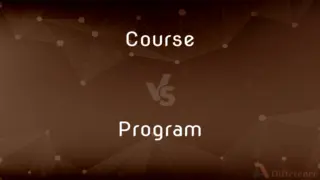Eastern Massage vs. Western Massage — What's the Difference?
By Tayyaba Rehman — Published on January 5, 2024
Eastern Massage focuses on balancing energy flow and holistic wellness, using techniques like acupressure. Western Massage emphasizes anatomical understanding and physical therapy, typically involving techniques like Swedish or deep tissue massage.

Difference Between Eastern Massage and Western Massage
Table of Contents
ADVERTISEMENT
Key Differences
Eastern Massage, rooted in ancient practices, aims at balancing the body's energy, often through methods like acupressure or reflexology. Western Massage, in contrast, focuses on anatomical and muscular structures, using techniques like Swedish massage to relieve physical tension.
The philosophy behind Eastern Massage involves a holistic approach, considering the mind, body, and spirit interconnected. Western Massage typically adopts a more clinical perspective, concentrating on specific muscular and skeletal issues.
Techniques in Eastern Massage often involve applying pressure to specific points, believed to correlate with other body parts. In Western Massage, the methods are more varied, including kneading, tapping, and gliding strokes, targeting muscle relaxation and injury recovery.
The diagnostic approach in Eastern Massage is unique, often including the examination of the tongue and pulse to understand energy imbalances. Western Massage usually begins with a physical examination, focusing on areas of tension or pain.
Eastern Massage is often part of a broader traditional medicine system, incorporating elements like herbal remedies. Western Massage, on the other hand, is commonly integrated into broader physical therapy and rehabilitation programs.
ADVERTISEMENT
Comparison Chart
Philosophy
Holistic, energy-focused
Anatomical, physical therapy-oriented
Techniques
Acupressure, energy pathways
Swedish, deep tissue, kneading
Diagnostic Approach
Energy balance, holistic
Physical assessment, muscle-focused
Integration
Part of traditional medicine
Often in rehabilitation, physical therapy
Goal
Energy balance, overall wellness
Muscle relaxation, injury recovery
Compare with Definitions
Eastern Massage
A holistic approach to massage, incorporating traditional Asian techniques.
The Eastern Massage included acupressure, significantly improving his chronic headaches.
Western Massage
Massage techniques often used for rehabilitation and physical therapy.
The athlete included Western Massage in his routine to prevent injuries.
Eastern Massage
A therapy focusing on energy flow and balance within the body.
She felt rejuvenated after her Eastern Massage session, which focused on restoring her energy balance.
Western Massage
A therapeutic practice rooted in modern anatomy and physiology.
His Western Massage targeted the deeper layers of muscle tissue, aiding in his recovery.
Eastern Massage
A therapeutic practice focusing on the body's meridians and energy points.
Eastern Massage helped him feel more balanced, targeting specific energy points in his body.
Western Massage
A diverse set of massage techniques including Swedish, deep tissue, and sports massage.
He chose a Western Massage style that combined Swedish and deep tissue techniques for maximum relief.
Eastern Massage
Massage practice based on ancient Eastern philosophy and medicine.
Eastern Massage is often recommended as part of a comprehensive wellness plan.
Western Massage
A massage style focusing on the body's muscular and skeletal system.
After the Western Massage, her tense muscles felt much more relaxed.
Eastern Massage
A form of massage that integrates body, mind, and spirit.
The Eastern Massage therapist used techniques that addressed not just her physical pain but also her emotional stress.
Western Massage
A methodical approach to massage, often emphasizing specific problem areas.
The Western Massage was particularly effective in relieving her lower back pain.
Common Curiosities
What is the main focus of Eastern Massage?
Eastern Massage focuses on energy flow and holistic wellness.
Can Eastern Massage involve herbal remedies?
Yes, it's often part of a broader traditional medicine system, including herbal remedies.
How does Western Massage view the body?
Western Massage views the body through a clinical lens, focusing on the muscular and skeletal system.
Is Western Massage good for injury recovery?
Yes, it's often used for physical therapy and rehabilitation, including injury recovery.
What techniques are common in Western Massage?
Techniques like Swedish, deep tissue, and kneading are common in Western Massage.
Do Eastern Massage therapists use pulse and tongue diagnosis?
Yes, these are common diagnostic methods in Eastern Massage to assess energy imbalances.
What is the goal of Eastern Massage?
The goal is to balance energy and promote overall wellness.
Are Western Massage techniques varied?
Yes, they include a wide range of methods like kneading, tapping, and gliding strokes.
What's the emphasis of Western Massage in therapy?
The emphasis is on addressing physical ailments, particularly in muscles and joints.
Is Eastern Massage based on traditional practices?
Yes, it's rooted in ancient Eastern philosophies and practices.
How do Eastern and Western Massage differ in philosophy?
Eastern Massage is holistic and energy-focused, while Western Massage is anatomical and therapy-oriented.
Can Western Massage be part of a physical therapy program?
Yes, it's often integrated into physical therapy and rehabilitation programs.
What makes Eastern Massage unique in approach?
Its holistic and energy-focused approach, considering the entire body system.
How does Western Massage help with physical issues?
It targets muscle relaxation and addresses specific areas of tension or pain.
Does Eastern Massage consider emotional wellbeing?
Yes, it integrates emotional, physical, and spiritual aspects for holistic health.
Share Your Discovery

Previous Comparison
Course vs. Program
Next Comparison
List in Java vs. ArrayList in JavaAuthor Spotlight
Written by
Tayyaba RehmanTayyaba Rehman is a distinguished writer, currently serving as a primary contributor to askdifference.com. As a researcher in semantics and etymology, Tayyaba's passion for the complexity of languages and their distinctions has found a perfect home on the platform. Tayyaba delves into the intricacies of language, distinguishing between commonly confused words and phrases, thereby providing clarity for readers worldwide.













































